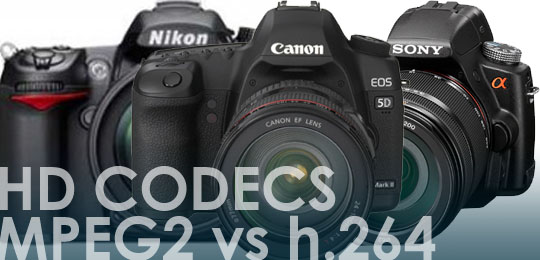HD Video Bitrate Standards – Clearing up the Confusion
While reading about the new Nikon D7000 and its initially unimpressive sounding HD video modes, I’ve come across a lot of opinions by many people who are disappointed about it’s possible 19.3 Mbps (Megabits per second) data rate. This includes many indie filmmakers thinking that rate may be too low for their purposes, myself included. We’ve all heard much about what are the good bitrates to look out for are, which ones are broadcast ready, which ones are crap and so on. Well, I stopped and asked myself, “Wait-a-minute, just what are these bitrate standards that we’re all using as reference?”. So I looked into the Mbps Broadcast Standard, sifting through the many online sites, white papers and essays, including ones about H.264 encoding itself and the results puts everything in perspective. Seriously.
The following are the bitrate standards for HD video those of us in the Broadcast field have come to know, love and hate:
- RAW uncompressed 1080p @60 fps – 3000 Mbps
- HD DVD – 28 Mbps
- Cable HD – 20 to 25 Mbps (although these days in Canada, Rogers & Bell are compressing the Hell out of their channels. It’s been mentioned that Rogers uses 10-14 Mbps while Bell is 10 Mbps)
- ATSC Over-the-Air Broadcast HD – 19.2 Mbps
- Digital cable MPEG2 (1920×1080, 1080i/p) – around 16 Mbps
- DVD (720×480, 480i) – 8 Mbps
The HD video bitrates look all right, don’t they? Please ignore that I left Blu-Ray, and some others off this list for now. My reason for this will become apparent. Even though these bitrates look good, they hide a misconception based on something that many do not even realize. The above Standard Bitrates are based on MPEG-2 compression implementation standards dating back to 1996. So the 20-25 Mbps rate that everyone seems to be quoting as Broadcast Quality(and comparing newer cameras like the D7000 against) is based on the old MPEG-2 compression.
You can see where the flaw in that is. H.264 is a very different, much better (Ed note: and more CPU intensive) compression scheme and as such cannot be directly compared to that 20-25 Mbps MPEG-2 standard. H.264 algorithms generally cram the same quality video as MPEG-2 in at least just a little under half the MPEG-2 data rate. On top end, these rates can greatly vary depending on specific components and complexity used in the H.264 algorithms. So for argument’s (and sanity’s) sake, I’ve used the very conservative multiplier of 2.3 times as an example to convert the H.264 rates into the MPEG-2 equivalents in order to illustrate my point here.
So the D7000’s 19.3 Mbps in H.264 is actually more like around 44.5 Mbps in MPEG-2 terms which means it’s more than broadcast quality.
For those of you who are curious, here are the other data rates for more recent media:
- Blu-Ray (H.264) – 40 Mbps
- Xbox Live Video VC-1 (1280×720, 720p) – 6.8 Mbps
- Apple iTunes QuickTime/H.264 (1280×720, 720p) – 4 Mbps
- Web “HD” downloads H.264 (1280×720, 720p) – 1.5 Mbps
Since Blu-Ray, iTunes Quicktime and Web “HD” downloads all use H.264, the same multiplier can be used. So in MPEG-2 equivalent terms:
- Blu-Ray’s 40 Mbps is actually 92 Mbps
- Apple’s iTunes Quicktime rate of 4 Mbps is really 9.2 Mbps
- Web “HD” downloads of 1.5 Mbps is 3.45 Mbps
I’m not really sure about the VC-1 encoding the Xbox Live Video uses, so if anyone knows anything about the compression algorithms and what multiplier to use to calculate the MPEG-2 equivalent, feel free to give me a comment.
So putting everything into perspective, the possible HD video bitrate for the new Nikon D7000 is looking pretty good at the MPEG-2 equivalent of 44.5 Mbps. Mind you, it also shows how good the Canon cameras are; the T2i/60D at 44 Mbps (H.264) is really 101.2 Mbps (MPEG-2) and the 7D/5DMK2’s 48 Mbps (H.264) is actually 110.4 Mbps (MPEG-2). Wow. Personally I am hoping that the 19.2 Mbps guesstimated datarate for the D7000 is wrong and that it will be higher than that, but time will tell.
I hope this article helps in clearing up some of the confusion surrounding bitrate standards when it comes to HD video.
If anyone is interested in reading further about this, here are the sources I used to research and reference. Once again, they are extremely technical:
Cheers.





[…] This post was mentioned on Twitter by Doug Groves, rgbFilter. rgbFilter said: HD Video Bitrate Standards – Clearing up the Confusion: While reading about the new Nikon D7000 and its initially … http://bit.ly/cEtit0 […]
Hi kingpinlei,
you’re seriously oversimplifying things here. Modern video compression is a very sophisticated topic. Even if two vendors implement the same standards, the quality and efficiency of their encoders can be miles apart, even with exactly the same data rate. It’s just once more one of these cases where a single number alone doesn’t really tell you anything at all. You need to analyse samples to check whether the quality is good enough for your purpose.
Whether Nikon will manage to get a decent quality source image with a ~20 Mbit Mpeg 4 implementation, I somehow doubt – remember, compression for acquisition should never be anywhere near the levels of compression for distribution (see the prolost.com website for a lot of good comments on this topic).
But to know it we need real world tests, everything else is really just guessing. Life is not as simple as using a multiplier to compare different compression implementations 🙂
Cheers,
Daniel
Thanks Daniel,
I totally agree with you on that Modern video codecs are very sophisticated, and yes, I am really really simplifying things here, but only so that I can clearly and concisely explain the situtation to a wide audience without having to write an entire thesis on the topic. The multiplier I used was only to illustrate as an example and should not be taken as a defacto standard by any means, hence my use of the phrase, “For arguements sake…”. But I may have to update my artcile to make it a bit clearer that the multiplier is only used as an example.
The main point of the article was to call into attention the video bitrates many people seem to be using to compare data rates from these new H.264/AVC-based cameras, not realizing that those bitrate standards they are referencing cannot be used as direct comparisons because they are based on the much older MPEG-2 compression. For example, I have heard many times people complaining that 19.3 Mbps is not Broadcast Quality because it is lower than 25 Mbps, but they are incorrect in their assumption because the 19.3 Mbps rate is actually H.264 and the 25 Mbps they reference is actually the much older MPEG-2 standard. This seems to be happening a lot.
Cheers. 🙂